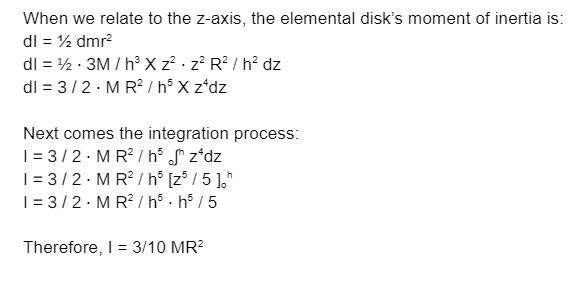A cone is a solid object having a circular base and a single tip (vertex). The vertex of a right cone is higher than the base’s centre. It’s considered to be an oblique cone if it isn’t. A ‘conical’ object is one that has a cone shape. The centre of mass of a cone is the point on the item where the object’s entire mass is uniformly distributed. Cones are divided into two types: solid cones & hollow cones. In this article, you’ll learn about the derivation of a centre of mass of a solid cone.
Before we learn about the derivation of a centre of mass of a solid cone, we must first see the mass moment of inertia and a solid cone.
Mass moment of inertia
The total of the mass, as well as the square of its perpendicular distance across the fixed point, expresses the mass moment of inertia of the physical item
The rotational counterpart of mass (which affects an object’s opposition to linear acceleration) is the moment of inertia, indicated by I. It quantifies the amount whereby a body opposes rotational acceleration around a given axis. The units of mass moments of inertia are ML²(mass * (length)²). The second moment of area, that is utilised in beam computations, must not be confused with this. The rotational inertia, as well as the angular mass, are terms used to describe the mass moment of inertia.
The moment of inertia may frequently be determined in an accurate closed-form equation for simple objects having geometric symmetry. This happens most of the time whenever the mass density is constant, however, it may also happen when the density varies across the item. In general, graphically expressing the moment of inertia of structures with more intricate mass distributions and asymmetry may be difficult. It’s helpful to remember that inertia is an additive function and to utilise the parallel axis & the perpendicular axis theorems when computing moments of inertia.
A solid cone
A cone is an object (solid) with a single point (vertex) and a circular base. A right cone is one in which the vertex is above the base’s centre. If it isn’t, it’s referred to as an oblique cone. A ‘conical’ item is one that is formed like a cone. The cone’s centre of mass is the place on the item around which the object’s whole mass is evenly distributed. There are two sorts of cones: solid cones and hollow cones.
Derivation of a centre of mass of a solid cone formula
We’ll use a solid cone with a radius of r and a height of h and an axis that passes through the centre. But, we must first determine the elemental disc’s mass.
The elemental disc’s mass is given by;


Conclusion
To conclude, for simple objects with geometric symmetry, the moment of inertia can usually be calculated using an exact closed-form equation. When the mass density is constant, this occurs most of the time; however, it can also occur when the density fluctuates over the object. The derivation of a centre of mass of a solid cone: If the mass of the cone is m & the radius of its base is R, the moment of inertia of a symmetrical solid cone with respect to its symmetry axis is I = 3/10 MR²
 Profile
Profile Settings
Settings Refer your friends
Refer your friends Sign out
Sign out













